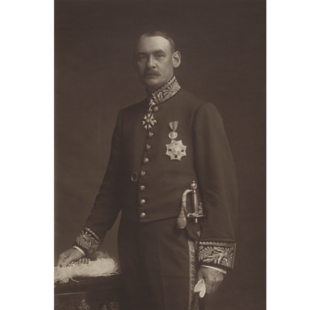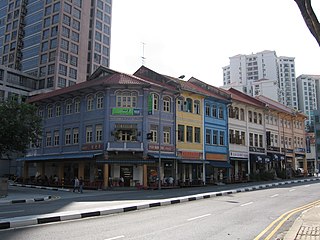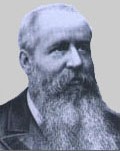
Singapore Standard Time (SST), also known as Singapore Time (SGT), is used in Singapore and is 8 hours ahead of UTC (UTC+08:00). Singapore does not currently observe daylight saving time.

Sir Edward Lewis Brockman was a colonial administrator who served briefly as the Colonial Secretary to the Straits Settlements in 1911 and was the chief secretary to the Federated Malay States (FMS) from 1911 to 1920. He announced the establishment of the Town Planning Committee to oversee Kuala Lumpur town planning service. He was descendant of the English Brockman family. Brockman Road in Kuala Lumpur was named after him, where the former Prime Minister office was located.

River Valley is a planning area located within the Central Area of the Central Region of Singapore. The planning area shares boundaries with Orchard in the north, Museum in the east, Tanglin in the west and Singapore River in the south.
Lim Koon Teck was a barrister-at-law, industrialist and politician in the Malaya and Singapore. He was the first Asian in the Straits Settlements to be appointed to the Colonial Legal Service. He was a magistrate at Penang and Crown Counsel, Singapore. After resigning government service, he joined the Lee Rubber Company. He was interested in introducing new construction methods, like lightweight concrete, to bring down building costs and was interested in helping to solve Singapore's housing shortage. These directed his commercial and political activities.
John Buttery was a merchant operating in the Straits Settlements of Penang, Malacca and Singapore. He was, at the time of his death, the senior partner of Sandilands, Buttery & Co., and John Buttery & Co..
Richard James Wilkinson was a British Colonial administrator, scholar of Malay, and historian. The son of a British Consul in Greece, Richard James Wilkinson, was born in 1867 in Salonika (Thessaloniki), Greece. After Felsted School was an undergraduate of Trinity College, Cambridge. He was multilingual and had a command of French, German, Greek, Italian and Spanish, and later, Malay and Hokkien which he qualified in, in 1889, while a cadet after joining the Straits Settlements Civil Service. He was an important contributor to the Journal of the Malayan Branch of the Asiatic Society (JMBRAS). On 7 November 1900 Wilkinson presented a collection of Malay manuscripts and printed books to the University of Cambridge Library. He was appointed CMG in 1912.

Sir William Thomas Taylor, was a British colonial administrator.

Sir John Frederick Dickson, was a British colonial administrator in Singapore. He was also President of the Straits Branch of the Royal Asiatic Society from 1886 to 1891. He translated and edited the Upasampadā-kammavācā and the Patimokkha.
Sir Hayes Marriott was a British colonial administrator. Marriott joined the Straits Settlement Civil Service in 1896 as a cadet and rose to the high position of Colonial Secretary before retiring in 1928.
Wilfred Lawson Blythe was a British colonial administrator. Blythe joined Malayan Civil Service as a cadet in 1921 and Chinese Protectorate before rising to the high position of Colonial Secretary of Singapore and retired in 30 July 1953.
Hugh Fraser (1891–1944), was a British colonial administrator. He was the last acting Colonial Secretary of Straits Settlements before the fall of Singapore in 15 February 1942 to the Japanese Occupation and was interned in Changi Prison. He subsequently died in Outram Road Prison in 1944.
Sir John Scott was a British colonial administrator. Scott joined the Ceylon Civil Service as a cadet in 1901 before retiring as Colonial Secretary of the Straits Settlement in 1933.
George Hemmant was a colonial administrator. He joined the Malayan Civil Service and was a cadet on 27 November 1903. He served most of his civil service career in Federated Malay States and Straits Settlements.
Edward Shaw Hose, was a colonial administrator. He served his civil service career in Federated Malay States and Straits Settlements and was the British Resident of Negri Sembilan and Colonial Secretary of Straits Settlements.
Sir Alexander Sym Small was a colonial administrator. He joined the Malayan Civil Service and was a cadet in January 1911 and served most of his Civil Service career in Federated Malay States (FMS) and Straits Settlements (SS). He retired as the Colonial Secretary of Straits Settlements in 1940.
Stanley Wilson Jones was a colonial administrator. He was a cadet of Malayan Civil Service in 1911 and spent his civil service career in Federated Malay States and Straits Settlements. He was the British Resident of Selangor and Colonial Secretary of Straits Settlements.
Frederick George Penney or Frederick Gordon Penney was a colonial administrator. He was a cadet of Straits Settlement in 1876 and retired as the Colonial Secretary of Straits Settlements in 1906.
Thomas Oxley (1805–1886) was Surgeon of the Straits Settlements. However, he is best remembered now as a plantation owner. Oxley Road, on which Lee Kuan Yew's house is sited, is named after him.





